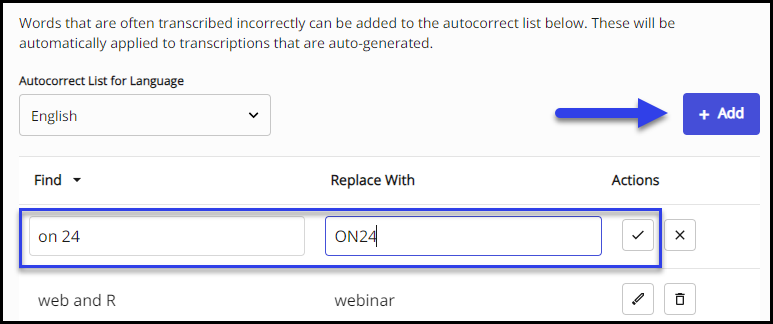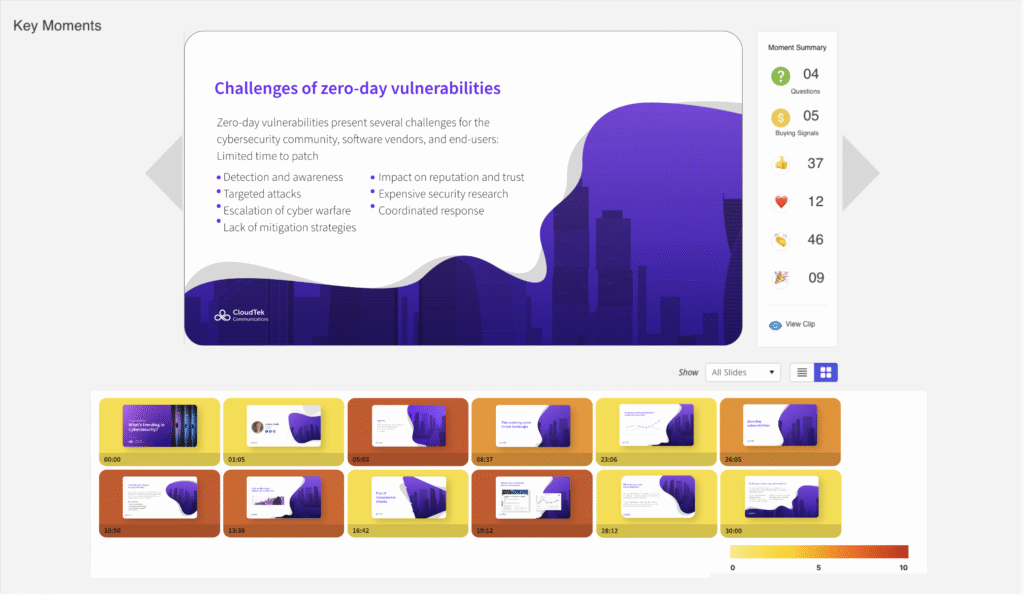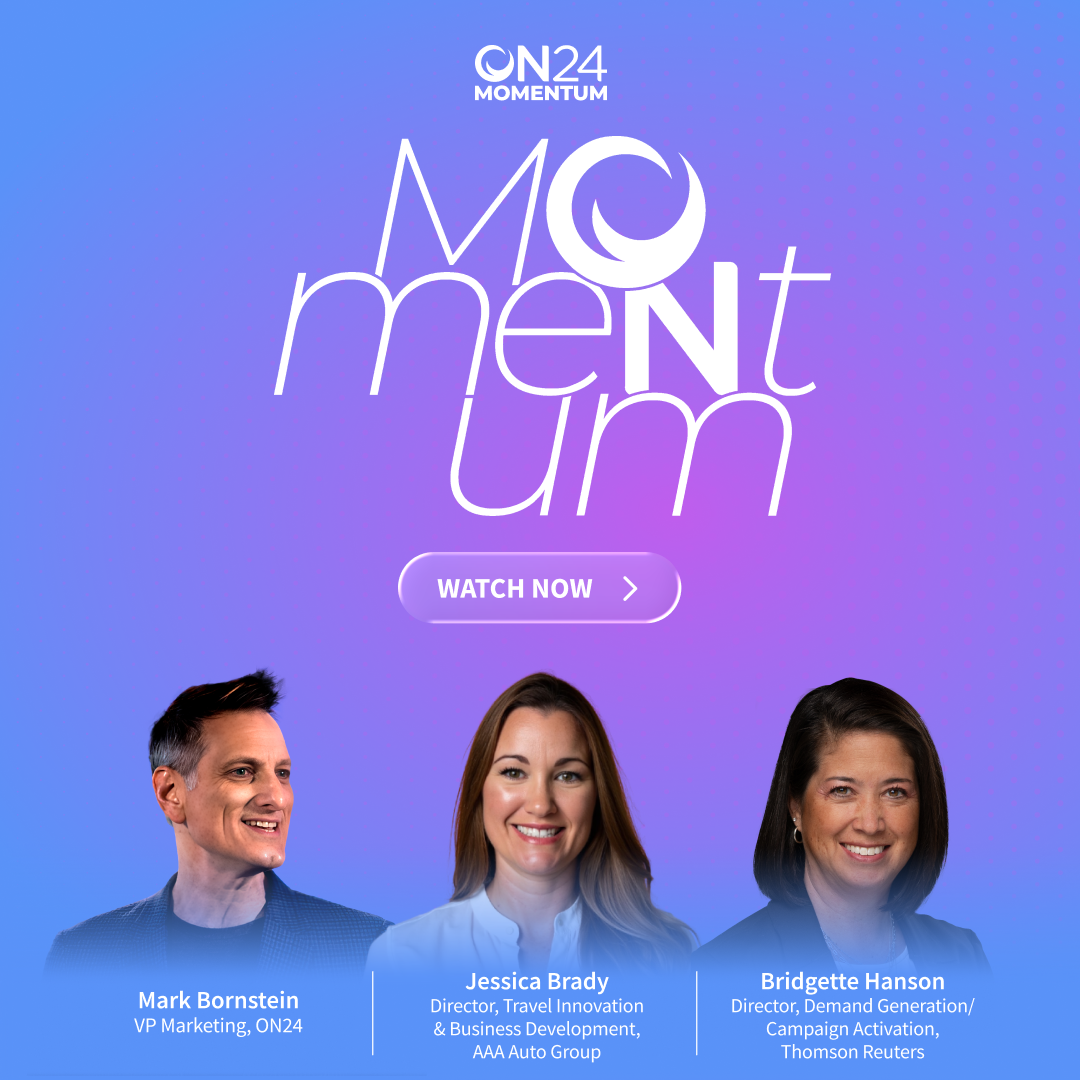Overview
-
Provide context and repeat key messages
Clarity and context supports audience understanding and AI-powered content.
-
Keep driving engagement and interaction
Prompt the audience to interact and use background staff to engage attendees.
-
Keep on-demand views in mind
Future-proof your webinar: make it replay-friendly from the start.
An AI-powered content strategy is only as good as the content it’s fed. That’s why, for B2B marketers, webinars are the perfect fuel for any AI content engine.
An average 50-minute webinar can generate around 10,000 words of high-quality, structured content. This provides a rich foundation for AI to then create a wide range of derivative assets, including blogs, ebooks and social media posts.
But how can you ensure your webinar delivers the best possible raw material for your AI?
Your transcript provides the potential and the context
The transcript from your webinar is the foundation of your AI-generated content. To get the best results, it’s crucial to set the stage for your AI from the very beginning. But having thousands of words to sift through isn’t enough — you need to set the context.
Context is important in AI because it helps the system understand exactly what you want it to do. Just like a person needs background information to give a helpful answer, an AI model needs the right details, instructions and tools to work well. If the model lacks clear or complete context, it can make mistakes, give outdated answers or miss the point completely. Phil Schmid from Google DeepMind has described successful context as providing “the right information and tools, in the right format, at the right time, to give a LLM everything it needs to accomplish a task.”
How do you set your webinar up for successful AI-generated content? Whether your webinar follows a strict script or you only have a general outline of what your speakers will discuss, there are a few things you can do to provide context.
Use the introduction to provide context for AI content repurposing
First off, use your moderator or speaker to cover three key points during their introduction of the webinar:
- Name the audience: State who the webinar is for.
- Identify their needs: Acknowledge the challenges and goals of the audience.
- Provide an agenda: Clearly outline what will be covered.
As an example, here’s how that might look in practice. For clarity, the audience, their needs, and the agenda points have been marked in bold.
“Thank you for joining us today. As B2B marketers, we are all facing the challenge of engaging prospects across digital channels. Today our experts will share four recommendations to help you address that, so this is what we will cover. We’ll start with recommendation 1: Clearly define your target audience and their needs. That follows into recommendation 2: Provide content, resources and offers that address these needs. Next, you need to target them, which is recommendation 3: Promote on the channels and in locations where they spend time. And finally, recommendation 4: Collect first-party data to assess intent and drive personalization, explore how to use personalized events to keep your audiences engaged while also gaining valuable first-party insights.”
Repeat your most important messages
Don’t stop at the introduction. Ensure that your key messages, phrases and points are said aloud. You may have these messages written on a slide, but that won’t show up on the transcript unless the speaker says it out loud.
Repetition is key. Repeating important points at the end of a section or in the summary reinforces them for both your audience and AI. Using numbered lists also provides clear context for AI to follow.
Prepare a custom dictionary to improve transcript quality
As anyone who has tried using a voice assistant can attest, AI-powered transcription is powerful, but it’s not perfect. Just like the human ear, even the clearest spoken words can be misheard. To avoid errors, it’s best practice to prepare a custom dictionary or autocorrect list. If you are an ON24 user, here’s how you can do that.

ON24 Transcription Autocorrect enables you to build a custom dictionary.
Some categories of terms you will want to consider adding to a custom dictionary include:
-
- Technical terms. For example, the term “predictive modeling” might be transcribed as “predictive muddling.”
- Acronyms. AI might transcribe “KYC” (Know Your Customer) as “can you see”.
- Brand terms of people’s names. A real-life example is “ON24” is often transcribed as “on 24” by some non-ON24 transcriptions.
- Words or phrases from other languages. As an example, “laissez-faire” might be incorrectly transcribed as “lazy fair”.
Try to avoid idioms, metaphors or unusual jargon. This is because AI may not understand the context. Additionally, if you are looking to create international content in different languages based on your transcribed webinar, idioms, metaphors and jargon might translate poorly.
Keep driving engagement and interaction
Engagement data acts as a way to identify which messages and content is resonating with your audience — pointing towards the parts of your webinar that, if repurposed, will likely drive more engagement from your target audience. As mentioned in the previous section, the webinar presenter should proactively and repeatedly drive engagement throughout the session.

With ON24, Key Moment video clips are generated from the parts of your webinar with the most engagement.
Having someone in the background can be particularly helpful for two reasons:
- Background staff can remind the speaker to call out engagement options. If someone else is following a plan that has prepared moments to drive engagement, they can remind the speaker ahead of time or nudge them if they forget.
- Background staff can interact with the audience directly. This can include answering questions, breaking the ice in attendee chat, or recommending options directly to viewers.
Keep on-demand views in mind when designing your webinar
In all cases, make sure to look to deliver your webinar with on-demand in mind.
This means you should use slide content and present in a way that does not seem out-of-place or incorrect for those watching after the point of live broadcast. Doing so makes it easier to reuse that content later, whether it be for simulive or repeat sessions. So, avoid using dates in your presentation slides or in your script.
Take on-demand into consideration when answering Q&A. Consider saying “We will answer your questions in the chat.” or “For those of you watching, on-demand, drop us a question and one of our team will get back to you soon.” You can still answer questions during the live presentation. This language gives you flexibility to select certain questions from the chat to address live, while keeping the phrasing broad enough for simulive or on-demand viewers.
How these work to fuel your campaign engine
Getting the most value out of your webinar means moving away from seeing it as an asset or touchpoint that is used once and never again.
By delivering your webinar using the tips above, you maximize its potential. A webinar with these foundations will enable you to:
- Repurpose your webinar into high-quality written content — enabling you to reach those who prefer to read rather than watch. power a campaign across channels and formats.
- Create shorter, more accessible video clips of Key Moments — helping to drive additional engagement on social media, engage time-pressed audiences and attract on-demand views.
- Curate derivative content into dedicated experiences, such as content hubs and personalized pages.
- Reuse your webinar once it is over — whether by delivering it as a simulive session, or as part of an on-demand library.
- More accurately translate your webinar and derivative content into different languages — allowing you to reach audiences in additional markets.




